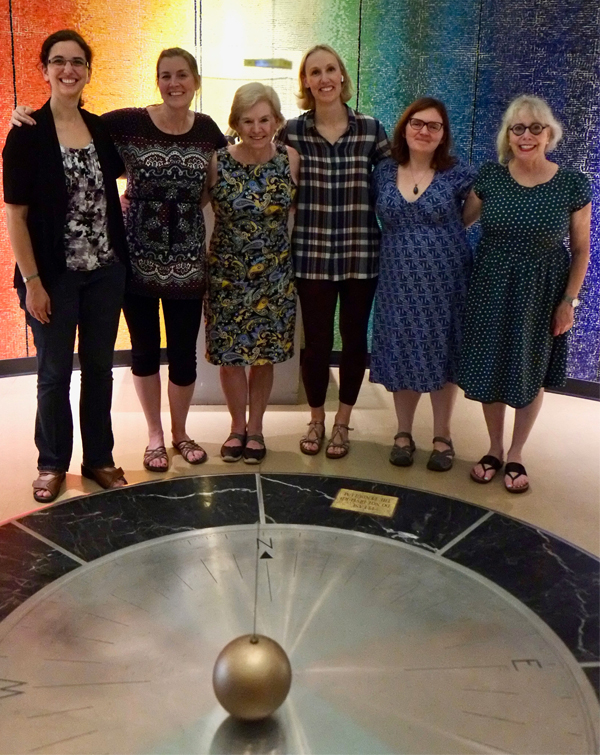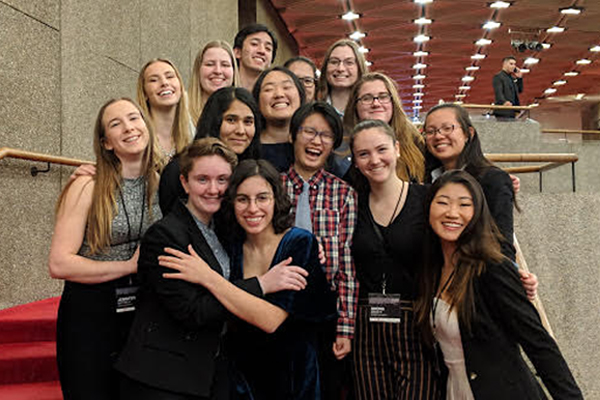Queen's-associated female astrophysicists

Queen's-associated female astrophysicists. Queen's long history of promoting women in astrophysics goes back to Allie
Queen's students at the 2019 CCUWIP

Solid-State Nanophotonic Spin Systems: Emerging Resource for Quantum Computing
Date
Wednesday March 24, 20212:30 pm - 3:30 pm
Location
ZoomTim Schröder
Humboldt University, Berlin
tim.schroeder@physik.hu-berlin.de
Abstract
Photonic Quantum Computation is an exciting research area that is presently catching a lot of attention, due to the recent demonstrations of quantum advantage in the optical domain, one of them by a Canadian company. Yet, it is still a far way to go to realize universal quantum computation. Here, I will give a short overview of the different approaches for photonic quantum information processing and sketch the pass towards overcoming the experimental challenges with defect centres in diamond that serve both for the implementation of stationary spin qubits as well as resources for the generation of photonic resource states. To achieve the required spin-photon interaction efficiencies, one possible solution is a nanophotonics approach based on diamond nanostructures and optical cavities. I will introduce our efforts towards efficient spin-photon interfaces and applying coherent control schemes for the implementation of quantum gates and the generation of photonic cluster states.
Dynamic beam steering with semiconductor metasurfaces
Date
Wednesday March 17, 20212:30 pm - 3:30 pm
Location
ZoomMuhammad Alam
Queens University
Abstract
Operation of conventional optical devices, for example lenses and mirrors depends on phase accumulation as light propagates through refractive materials. An emerging alternative is metasurface, which consists of ultrathin subwavelength optical elements. Tunable metasurfaces enable dynamical control of properties of light at a subwavelength scale and will be useful for many applications including beam steering, dynamical holography and tunable flat lenses. To date, most of the electrically tunable metasurfaces have been realized using free carrier modulation, and switching of thermo-optical, liquid crystal and phase change media. However, the highest performance and lowest loss discrete optoelectronic modulators exploit the electro-optic effect in multiple-quantum-well heterostructures. I will describe how successful adoption of quantum-well heterostructures for achieving tunability can over overcome the limitations of tunable metasurfaces reported to date. I will discuss numerical and experimental results that highlight the promise of this approach and the challenges which need to be overcome before this becomes a successful technology.
For the zoom link please contact Colin Vendromin
Understanding Planetary System Formation Through Astrochemistry
Date
Friday March 12, 20211:30 pm - 3:30 pm
Location
ZoomLauren Ilsedore Cleeves
University of Virginia
Abstract
The Sun is not expected to be a bright gamma-ray source above 1 GeV, due to the moderate strength of solar magnetic fields. However, the Sun may act as a passive gamma-ray source, through the hadronic interaction of galactic cosmic rays with the Solar atmosphere. The Fermi-LAT has detected a bright solar gamma-ray flux, which implies that solar magnetic fields efficiently redirect incoming cosmic rays and produce outgoing gamma-ray emission. Here, I will show new observations, including the first resolved imaging of this gamma-ray signal across the solar surface, that find three surprising results. First, the gamma-ray emission extends to energies above 200 GeV, implying that Solar magnetic fields can redirect TeV protons. Second, the morphology and spectrum of gamma-ray emission varies significantly over the solar cycle. Third, a significant “spectral-dip” appears between energies of 30-50 GeV. These observations are in significant tension with all current models of solar gamma-ray production.
Evidence for a New Component of Solar Gamma-Ray Emission
Date
Friday March 5, 20211:30 pm - 2:30 pm
Location
ZoomTim Linden
Stockholm University
Abstract
The Sun is not expected to be a bright gamma-ray source above 1 GeV, due to the moderate strength of solar magnetic fields. However, the Sun may act as a passive gamma-ray source, through the hadronic interaction of galactic cosmic rays with the Solar atmosphere. The Fermi-LAT has detected a bright solar gamma-ray flux, which implies that solar magnetic fields efficiently redirect incoming cosmic rays and produce outgoing gamma-ray emission. Here, I will show new observations, including the first resolved imaging of this gamma-ray signal across the solar surface, that find three surprising results. First, the gamma-ray emission extends to energies above 200 GeV, implying that Solar magnetic fields can redirect TeV protons. Second, the morphology and spectrum of gamma-ray emission varies significantly over the solar cycle. Third, a significant “spectral-dip” appears between energies of 30-50 GeV. These observations are in significant tension with all current models of solar gamma-ray production.
Quantum scars and non-thermal phenomena in many-body quantum systems
Date
Friday February 26, 20211:30 pm - 2:30 pm
Location
ZoomFiona Burnell
University of Minnesota
Abstract
There are a few well-known ways for quantum mechanical, many-body systems to avoid coming to thermal equilibrium. For example, we know of two classes of systems -- integrable systems, and many-body localized systems -- for which conservation laws prevent any eigenstate from reaching (conventional) thermal equilibrium. More recently, a much more subtle type of non-thermal quantum phenomenon has been discovered, dubbed many-body quantum scars. In these systems, a small number of eigenstates (and hence a small number of initial conditions) have non-thermal behavior, while most initial states will approach thermal equilibrium in the usual way. I will give a general picture of how and when this phenomenon arises, and discuss several examples of systems exhibiting exact quantum many-body scars.
Towards a Quantum Network of Superconducting Nodes using Surface Acoustic Waves and Semiconductor Quantum Dots
Date
Wednesday February 24, 20212:30 pm - 3:30 pm
Location
ZoomKevin Silverman
NIST (Boulder) Quantum Nanophotonics Group
Abstract
A quantum network will enable fundamentally new capabilities by linking remotely located quantum processors. NIST has recently funded a 5-year program to build a prototype system of linked superconducting qubits. With such a system in hand, it will be possible to study the metrology and standards necessary to support future networks. A major technological challenge is faithfully converting quantum information stored in the superconducting qubits to optical photons. One promising scheme involves using surface acoustic wave cavities and semiconductor quantum dots.
When the Universe Was One Second Old: A Laboratory for Neutrino and Beyond Standard Model Physics
Date
Friday February 12, 20211:30 pm - 2:30 pm
Location
ZoomGeorge Fuller
UC San Diego
Abstract
Mysteries abound in the physics of neutrinos and related possible dark sectors. Early in its history, the universe is dominated by neutrinos, their energy density and interactions. The imminent advent of 30-m class telescopes and Stage-4 cosmic microwave background observatories promises to give us precision measurements of key parameters which are set in this epoch. For example, we may soon know to fair precision the amount of relic relativistic energy and the deuterium and helium abundances set during the time when the neutrinos fall out of thermal and chemical equilibrium (age ~ 1 s). Given the excitement and ferment right now surrounding new ideas in dark matter, dark sector, and other beyond standard model (BSM) physics, we would very much like to leverage these coming measurements into deeper insights into this epoch, in effect turning the early universe into a precision BSM physics laboratory. Doing so, however, requires theorists to "raise their game” in modeling the neutrino decoupling epoch. We will discuss these issues and reveal some surprising features of the universe when it was roughly one second in age.
 Queen's 2015 Nobel Prize in Physics
Queen's 2015 Nobel Prize in Physics